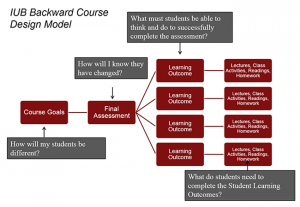 A syllabus can be a creative and integrative expression of graduate students’ academic and pedagogical interests. Whether graduate students are applying to teach for their department, Collins, or Global Village, or preparing for academic job interviews, they can use the syllabus to showcase how they would teach their dissertation topic. It can be tempting, however, to simply “cover” all of the core texts of the topic to show breadth of content knowledge. If instead the goal is to foster deep learning and to show pedagogical creativity, the CITL staff suggests using the backward course design model (Wiggins and McTighe 2005) when constructing your course. Here is a simplified version of those steps:
A syllabus can be a creative and integrative expression of graduate students’ academic and pedagogical interests. Whether graduate students are applying to teach for their department, Collins, or Global Village, or preparing for academic job interviews, they can use the syllabus to showcase how they would teach their dissertation topic. It can be tempting, however, to simply “cover” all of the core texts of the topic to show breadth of content knowledge. If instead the goal is to foster deep learning and to show pedagogical creativity, the CITL staff suggests using the backward course design model (Wiggins and McTighe 2005) when constructing your course. Here is a simplified version of those steps:
-
- Rather than starting with readings and topics you want to cover, in this model you design the course based on course goals and learning outcomes. Ask yourself:
- What do you want students to be able to do and to know when they finish your course?
- How will your students be different when they leave your course?Use language to write specific and measurable course goals. For guidance on how to do so, check out Bloom’s taxonomy (Anderson and Krathwohl 2001).
- Now you’ve addressed what you want students to be able to do and know when they finish your course. Next, it’s time to figure out what students will produce at the end of the semester that will provide evidence of their achievement of the course goals. Design a final assignment or assessment that provides direct evidence for those goals.
- Lastly, you can start to flesh out your syllabus and decide what class activities, homework, readings, and lectures will serve as scaffolding steps for your students to successfully complete their final assessment.
- Rather than starting with readings and topics you want to cover, in this model you design the course based on course goals and learning outcomes. Ask yourself:
With this approach to constructing a syllabus, you think less about what specific texts and lectures you want the students to receive and instead focus on how you want students to develop through your class.
When constructing a syllabus, it’s always helpful to see some examples. If you’re a graduate student, you may also want to sign up for a pedagogy course this fall in which you can learn topics like this. Similarly, our Talking About Teaching Graduate Student Learning Community (offered Fall 2017) covers how to make a syllabus and more. Come to our upcoming AI Orientation to learn more about all that CITL can offer you!

Leave a Reply